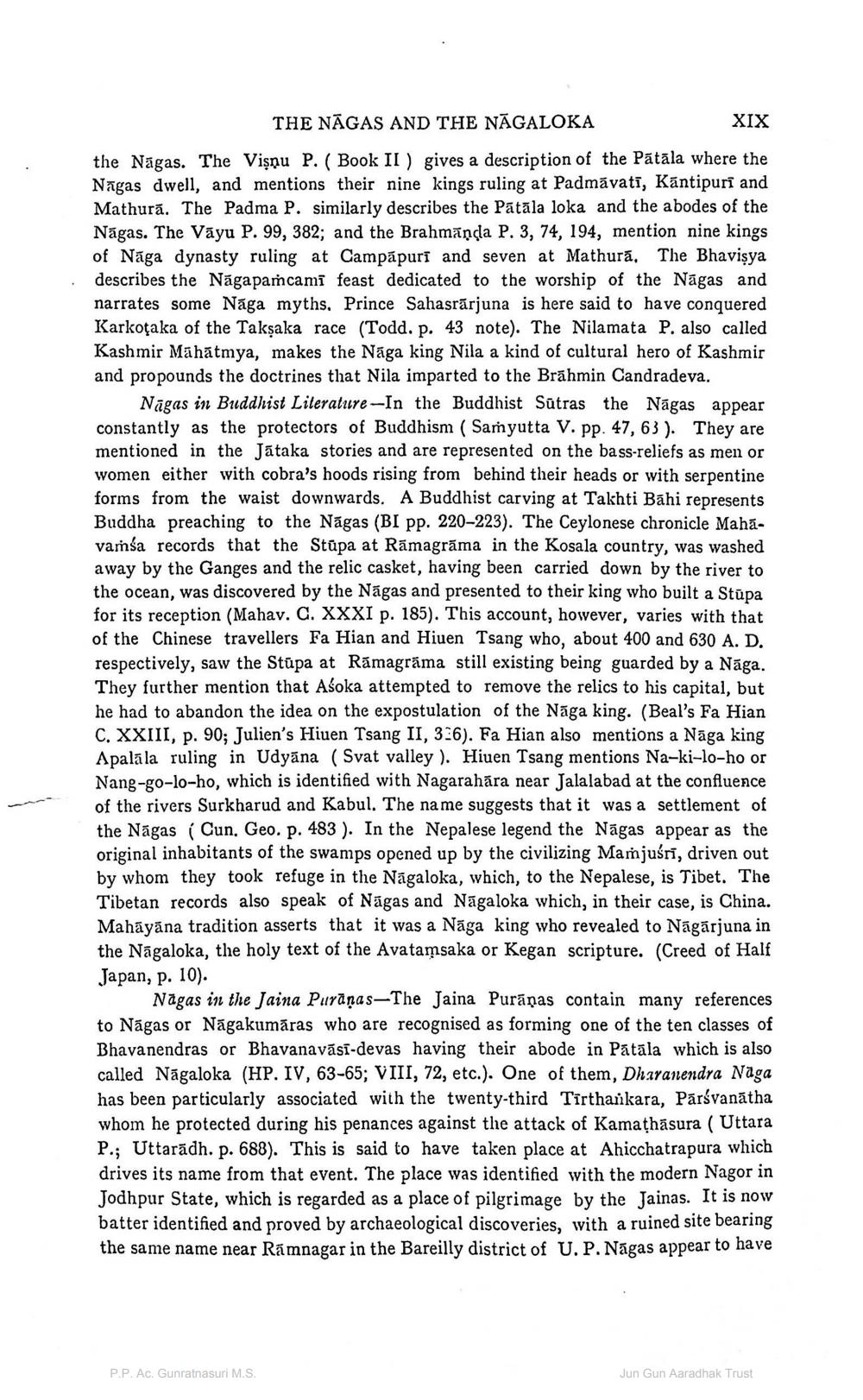________________ THE NAGAS AND THE NAGALOKA XIX the Nagas. The Visnu P. ( Book II) gives a description of the Patala where the Nagas dwell, and mentions their nine kings ruling at Padmavati, Kantipuri and Mathura. The Padma P. similarly describes the Patala loka and the abodes of the Nagas. The Vayu P. 99, 382; and the Brahmanca P. 3, 74, 194, mention nine kings of Naga dynasty ruling at Campapuri and seven at Mathura. The Bhavisya describes the Nagapamcami feast dedicated to the worship of the Nagas and narrates some Naga myths, Prince Sahasrarjuna is here said to have conquered Karkotaka of the Taksaka race (Todd. p. 43 note). The Nilamata P. also called Kashmir Mahatmya, makes the Naga king Nila a kind of cultural hero of Kashmir and propounds the doctrines that Nila imparted to the Brahmin Candradeva. Nagas in Buddhist Literature-In the Buddhist Sutras the Nagas appear constantly as the protectors of Buddhism ( Samyutta V. pp. 47,63 ). They are mentioned in the Jataka stories and are represented on the bass-reliefs as men or women either with cobra's hoods rising from behind their heads or with serpentine forms from the waist downwards. A Buddhist carving at Takhti Bahi represents Buddha preaching to the Nagas (BI pp. 220-223). The Ceylonese chronicle Mahavarsa records that the Stupa at Ramagrama in the Kosala country, was washed away by the Ganges and the relic casket, having been carried down by the river to the ocean, was discovered by the Nagas and presented to their king who built a Stupa for its reception (Mahav. C. XXXI p. 185). This account, however, varies with that of the Chinese travellers Fa Hian and Hiuen Tsang who, about 400 and 630 A. D. respectively, saw the Stupa at Ramagrama still existing being guarded by a Naga. They further mention that Asoka attempted to remove the relics to his capital, but he had to abandon the idea on the expostulation of the Naga king. (Beal's Fa Hian C. XXIII, p. 90; Julien's Hiuen Tsang II, 3:6). Fa Hian also mentions a Naga king Apalala ruling in Udyana (Svat valley ). Hiuen Tsang mentions Na-ki-lo-ho or Nang-go-lo-ho, which is identified with Nagarahara near Jalalabad at the confluence of the rivers Surkharud and Kabul. The name suggests that it was a settlement of the Nagas ( Cun. Geo. p. 483 ). In the Nepalese legend the Nagas appear as the original inhabitants of the swamps opened up by the civilizing Mamjusri, driven out by whom they took refuge in the Nagaloka, which, to the Nepalese, is Tibet. The Tibetan records also speak of Nagas and Nagaloka which, in their case, is China. Mahayana tradition asserts that it was a Naga king who revealed to Nagarjuna in the Nagaloka, the holy text of the Avatamsaka or Kegan scripture. (Creed of Half Japan, p. 10). Nagas in the Jaina Puranas-The Jaina Puranas contain many references to Nagas or Nagakumaras who are recognised as forming one of the ten classes of Bhavanendras or Bhavanavasi-devas having their abode in Patala which is also called Nagaloka (HP. IV, 63-65; VIII, 72, etc.). One of them, Dharanendra Naga has been particularly associated with the twenty-third Tirthaikara, Parsvanatha whom he protected during his penances against the attack of Kamathasura (Uttara P.; Uttaradh. p. 688). This is said to have taken place at Ahicchatrapura which drives its name from that event. The place was identified with the modern Nagor in Jodhpur State, which is regarded as a place of pilgrimage by the Jainas. It is now batter identified and proved by archaeological discoveries, with a ruined site bearing the same name near Ramnagar in the Bareilly district of U.P. Nagas appear to have P.P.AC. Gunratnasuri M.S. Jun Gun Aaradhak Trust




